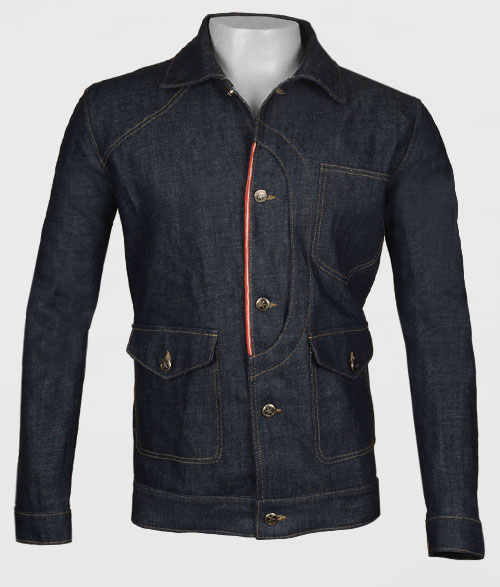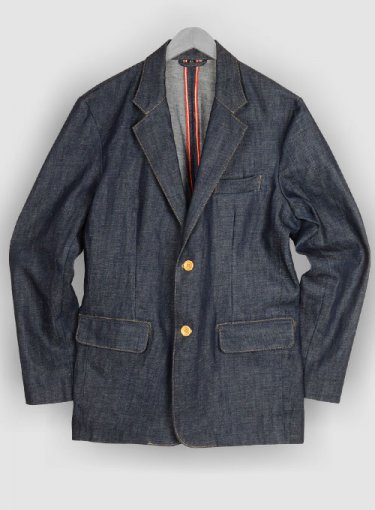A good jacket can last a lifetime, offering the perfect combination of style, comfort and durability. But unfortunately, finding such a jacket isn’t always easy. Even if it “looks” nice, it may suffer from poor craftsmanship, breaking down and succumbing to damage shortly after you buy it. This is why it’s recommended that you follow the “quality over quantity” mantra. A single high-quality jacket is far more valuable than two or three low-quality jackets.
While 100% denim jackets are an excellent choice, you can go one step further by choosing a selvedge denim jacket. But what exactly is selvedge denim? And why is it better than regular denim? Most people have at least heard of selvedge denim before, yet few know its true characteristics. If you’re still trying to grasp the concept of selvedge denim, keep reading. In today’s post, we’re going to explore this term and what it means.
What is Selvedge Denim?
Basically, selvedge denim is the edge of denim fabric as it exits the loom. Unlike traditional fabrics, they are typically woven or kit to prevent fraying, curling or other common problems faced by traditional fabrics.
Selvedge denim is made using a single continuous spool of cross yard (known as the weft) that’s passed back through the vertical warp beams of the loom. The end result is an ultra-high-quality fabric that’s finished at both edges, featuring a contrasting warp that’s usually red in color. Some people refer to this high-end denim as “red selvedge” due to its red warp color. While this is the single most common way in which selvedge denim is made, it can also be made using a shuttle loom. This alternative method, however, is a bit more time-consuming and tedious, which is why mos people prefer the original method.
How to Identify Selvedge Denim
From an outsider’s perspective, a traditional denim jacket properly looks the same as a selvedge denim jacket — and that’s not necessarily a bad thing. Both regular and selvedge denim share some striking characteristics, such as color, tone, structural integrity and style. But there also some subtle differences between the two that shouldn’t go unnoticed.
A quick and easy wall to distinguish between traditional denim and selvedge denim is to look for the red lines, which normally run along the outseam. As stated above, selvedge denim contains a warp that’s made in a contrasting color as the rest of the fabric, which in the case of traditional denim is usually red. So if you’re trying to determine if a jacket, pair of jeans or any other garment is made of selvedge denim, look for this distinct characteristic. The presence of red fabric along the outseams is usually indicative of the garment being made with selvedge denim.
Benefits of Selvedge Denim
Is there any real advantage to choosing a selvedge denim jacket over a traditional, non-selvedge denim jacket? The short answer is yes. Some fashion experts refer to selvedge as the cashmere of denim, which sums up the fabric pretty nicely. Sure, it’s harder to find than traditional denim, and it usually costs more, but the difference in quality is like night and day. From the moment you first feel selvedge denim, you’ll realize what all of the fuss is about.
Selvedge denim has a crisp edge on the interior seams, allowing for a cleaner look. And because the edges are crisp and clean, they are less susceptible to fraying and curling. Traditional denim jackets may damage at the end of the seams. Thankfully, this isn’t a problem from which selvedge denim suffers, as the ends are crisp and cleanly cut. Although small and subtle, it’s the little differences such as this that make selvedge denim worth the extra cost.
Another benefit of selvedge denim is its strength and durability. While traditional denim is also strong and durable, selvedge denim is particularly resistant to damage. So if you’re looking for a new denim jacket to wear outdoors, selvedge is probably the way to go.
Tips on Choosing a Selvedge Denim Jacket:
- Make sure the selvedge denim jacket is made of REAL selvedge. Some companies cut corners by selling regular denim as selvedge. They’ll use colored denim on the seams to mimic the appearance of real selvedge. If you look closely, however, you’ll notice the seams are rugged rather than clean, indicating that it’s not real selvedge. Always double-check to ensure any selvedge denim jacket that you are thinking about buying is made of real, genuine selvedge denim.
- Does the denim jacket contain other fabrics or materials in addition to selvedge denim? While some selvedge denim jackets contain 100% selvedge denim, others contain a mixture of selvedge denim and cotton, wool and/or other materials.
- How thick is the selvedge denim jacket? Conventional wisdom should tell you that thicker jackets are best suited for cold weather, whereas lighter jackets are better suited for warm weather. And being that it’s still summer, a thinner selvedge denim jacket is probably the right choice.
- How many buttons does the selvedge denim jacket contain? Buttons are dual-purpose, offering both functional and aesthetic benefits. They’ll keep your jacket secured in place while also providing storage space (when used for pockets). Look to see how many buttons a selvedge denim jacket has before buying it. In addition to the number of buttons, you should also check to see where they are located.
- Don’t underestimate the importance of choosing the right size selvedge denim. If the jacket is too big, it will puff out while creating an awkward appearance. On the other hand, if the selvedge denim jacket is too small you may find it difficult and/or uncomfortable to wear. If you’re struggling to find a genuine selvedge denim jacket available in your side, consider ordering one here at LeatherCult. You can specify your own measurements during checkout, meaning your jacket will fit you perfectly.
- Whether you’re a man or women, you really can’t go wrong with the Selvedge Denim Jacket 541. Offered exclusively here at LeatherCult, this stylish jacket is made using only the finest quality selvedge denim.


